8
Knock Your Socks Off Service Fitness: Taking Care of You

Learning Objectives
By the end of this chapter, you should be able to:
• Use ten stress reduction techniques.
• Maintain work relationships that are both professional and friendly.
• Assess your current customer service competency level.
• Set goals for improving your customer service competency levels.
• Describe five methods for celebrating successes.
INTRODUCTION
We’ve focused our attention mainly on the customer. But there’s another important player in the service game: you. A savvy service professional learns that self-management is every bit as important as managing the customer’s experience. This chapter focuses on four aspects of self-management: managing stress, maintaining professional work relationships with customers and coworkers, building your professional competencies through continuous learning, and recognizing and celebrating your successes.
How you feel about yourself and the job you are doing—whether you love it or are overwhelmed by it—will inevitably be reflected in the quality of your work. Knock Your Socks Off Service should be rewarding for everyone involved.
MASTER THE ART OF CALM
You’re not any good to anyone when you are stressed up, stressed out, overwrought, anxious, moody, belligerent, nasty, and still waiting for that first cup of coffee. The emotional labor involved in modern service jobs can actually be more draining than lifting boxes or pouring concrete. All the good stuff built into your job will never be enough if you don’t learn how to cope with and counteract the stress.
In theme parks from Disneyland and Walt Disney World to Knott’s Berry Farm, Opryland, and Carowinds, people at the front lines are taught the concepts of onstage and offstage. Onstage is anywhere a customer can see or hear you. Offstage is everywhere else, safely away from the public eye.
An employee who is feeling stressed can ask a supervisor to take over the ride operation, concession stand, or broom so they can get themselves back together. Once offstage, they can let their emotions out, deal with them, put their game face back on, and come back to the job without worrying about putting their next customer through the third degree.
You, your manager, and your organization have to work together to manage the environment in which you work. But only you can manage the way you react to a given service encounter. How do you cope? There are any number of techniques for reducing stress, whether inside your cubicle or out on the sales floor. Find those that work best for you and practice them every day. Ten widely used techniques follow. See Exhibit 8–1, Stress Reducers.
Ten Stress Reducers
1. Breathe
Deep breathing is one of the oldest stress-busting techniques, and one of the best. Stress can upset the normal balance of oxygen and carbon dioxide in your lungs. Deep breathing corrects this imbalance, relaxes you, and helps you control panic thinking. Deep breathing can be used alone or in conjunction with other relaxation exercises such as one-minute vacations (technique number 5) and progressive muscle relaxation (technique number 6). To practice deep breathing, do Exercise 8-1, Apply What You Learn: Deep Breathing, now.
1. Breathe
2. Smile
3. Laugh
4. Let it out
5. Take a one-minute vacation
6. Relax
7. Exercise
8. Organize
9. Talk positively
10. Take a health break
![]() Exercise 8-1.
Exercise 8-1.
Apply What You Learn: Deep Breathing
1. Take a deep breath through your nose.
2. Hold the breath for seven seconds (no more). Count “one thousand one, one thousand two,” etc.
3. Exhale slowly through your mouth.
4. Imagine tension flowing out as you exhale.
5. Focus on your feeling of relaxation as you exhale.
Repeat this exercise three to six times.
How did you feel when you started the breathing exercise?
__________________________________________________________
__________________________________________________________
(Sample answers: tense, tired, self-conscious, ridiculous.)
How do you feel now?
__________________________________________________________
__________________________________________________________
__________________________________________________________
(Sample answers: calm, refreshed, relaxed, a few cobwebs are gone.)
2. Smile
You make your mood, and your mood can stress or relax you. Smiling is contagious. When you see a customer looking a little glum, make eye contact and turn on one of your best and brightest. Ninety-nine times out of a hundred, you’ll get a smile right back.
Good service is not smiling at the customer, but getting the customer to smile at you.
—Dr. Barrie Hopson and Mike Scally
12 Steps to Success Through Service
Maintaining a sense of humor is your best defense against stress. Some ways to use humor to manage your stress response include:
• Look for the humor in the situation.
• Don’t take yourself too seriously. Be able to laugh at yourself.
• Take a phone or coffee break with a friend who sees the funny side of life or who is a natural comic.
• Keep a book of humorous quotes, quips, anecdotes, or cartoons at your desk. When you need a humor break, randomly open to any page, get a chuckle, and reset your mood.
A Word of Caution: Be sure the humor is in good taste and appropriate for the work place.
• Watch a funny movie or tune your TV to a situation comedy.
• Check out the joke of the day on the Internet.
4. Let It Out
Keep your anger and frustration locked up inside and you are sure to show it on the outside. Instead, make an appointment with yourself to think about a particularly stressful customer later—and then keep the appointment. Unacknowledged tension will eat you up, but delaying your reaction to stress-causing events can be constructive. It puts you in control.
To get extra value from the technique, keep a stress log of your most frustrating customers and situations. Adding an entry to the log helps calm you, and over several years the log can become a guide to dealing with your stress load. Begin keeping your stress log by using the worksheet in Exercise 8-2.
5. Take a One-Minute Vacation
Think of a place that you find restful and relaxing—a shady mountain stream, a white-sandy beach in the Caribbean, a peaceful garden. Create a vivid image of yourself in that place. Work on the scene until you can experience being there and lose all sense of time and place, even though your mental visits last only a minute or two. Now you can easily return to your “favorite place” following a stressful call or before talking to a stress-inducing customer.
![]() Exercise 8-2. Apply What You Learn: Stress Log
Exercise 8-2. Apply What You Learn: Stress Log
Instructions: Use this stress log to record and analyze your stressors.
1. In Column A, enter the date.
2. In Column B, describe the stress event, including the situation and the customer.
3. In Column C, describe your response.
4. In Column D, describe what you learned from this event.
5. In Column E, describe how you would respond to the situation next time.

![]() Think About It...
Think About It...
1. Where will you go on your one-minute vacation?______________
2. Write a description of your one-minute vacation place.
__________________________________________________________
__________________________________________________________
__________________________________________________________
__________________________________________________________
__________________________________________________________
![]() Exercise 8-3. Apply What You Learn: Tensing and Relaxing Muscles
Exercise 8-3. Apply What You Learn: Tensing and Relaxing Muscles
1. Clench your right fist, then relax it. Clench your left fist, then relax it. Clench both fists, then relax.
2. Bend your elbows, tense your biceps, then relax.
3. Tighten your stomach muscles, then relax them.
6. Relax
We tend to hold in tension by tightening our muscles. Instead, try progressive muscle relaxation: tensing and relaxing specific muscles or muscle groups. For instance, make a fist, then relax it. By creating an awareness of tension and relaxation, these exercises help you learn to relax your muscles. They also help you discover which of your muscle groups express tension most often. When you learn to recognize your body’s tension signals, you can relax the affected muscle groups before you get a headache or backache, for example. Go to Exercise 8-3, Tensing and Relaxing Muscles, and practice some progressive muscle exercises.
You can use progressive muscle relaxation to relax only certain muscles, as you have just done in Exercise 8-3, or it can be used to relax completely. For instance, to exercise a specific muscle group, you can shrug one shoulder, then the other, then both at your desk to loosen up those muscles. Complete relaxation, on the other hand, proceeds through all the major muscle groups, relaxing them one at a time. To practice complete relaxation, find a quiet place and stretch out on the floor. Then spend between fifteen and twenty minutes doing the exercises, which will lead to total relaxation.
7. Exercise
Exercise, especially noncompetitive exercise, is a great way to work off stress— and stay trim and fit as well. And there are lots of possibilities: Walk, jog, run, swim, or bike. Take an aerobics class or go dancing. Join a fitness center and work out on the stair-climber machine, rower, or treadmill. You can even do some simple, stress-reducing exercises right at your desk. Try the two “desk-er-cizes” described in Exercise 8-4.
A Word of Caution: Always check with your physician before beginning an exercise program.
8. Organize
Organizing gives you a sense of control and lessens your stress level. Try organizing the top of your desk whenever you are waiting on hold. Before leaving for the day, put everything away, and make a list of priorities for the next day.
![]() Exercise 8-4. Apply What You Learn: “Desk-er-cizes”
Exercise 8-4. Apply What You Learn: “Desk-er-cizes”
• While sitting at your desk, raise your feet until your legs are almost parallel to the floor. Hold them there, then let them down. Do this five times.
• Rotate your head forward and from side to side (but not back—that can strain rather than stretch). Roll your shoulders forward and then lift them up and back. This feels especially good after you’ve been sitting or standing for some time.
• What desk-er-cizes do you like to do?
__________________________________________________________
__________________________________________________________
__________________________________________________________
• Start collecting additional desk-er-cizes.
__________________________________________________________
__________________________________________________________
__________________________________________________________
![]() Think About It...
Think About It...
What can you do at the end of each work day to be better organized for the next work day?
__________________________________________________________
__________________________________________________________
__________________________________________________________
(Sample answers: straighten desk, make a to-do list for tomorrow, back up files.)
9. Talk Positively
Vent your anger and frustration in positive ways. Sharing customer encounters with coworkers helps you find the humor in the situation and gain new ideas for handling similar situations. But constant negative talk that rehashes old ground will only re-create and reinforce, not diminish, your stress. 7b accentuate the positive in your work environment, complete Exercise 8-5, Apply What You Learn: Accentuate the Positive.
![]() Exercise 8-5. Apply What You Learn: Accentuate the Positive
Exercise 8-5. Apply What You Learn: Accentuate the Positive
For the next five work days, carry a 3” × 5” card with you. Draw a line down the center of the card. On the left side of the card, keep a tally of the positive comments you make to yourself and others throughout the day. Tally the negative comments on the right side. At the end of your shift, add up the number of positive and negative comments. Each day try to increase the number of positive comments and decrease the negative ones.
10. Take a Health Break
Turn your normal breaks into health breaks. Consider walking outside, reading a chapter from a favorite book, or just sitting with your eyes closed for a few minutes. Bring healthy snacks and juice to work to substitute for the standard coffee and doughnuts.
![]() Think About It...
Think About It...
List three steps you will take to turn your normal breaks into health breaks.
1. _______________________________________________________
2. _______________________________________________________
3. _______________________________________________________
To paraphrase: You only serve as good as you feel. You need to take care of yourself. And you are the only one who can. As service quality expert Chip Bell has observed, “When your customer is the most anxious, you need to be at your best—most competent, confident, calmest, and in control of yourself.”
KEEP IT PROFESSIONAL
Today, it’s common to hear executives and managers proclaim, “Customers are our best friends.” But Knock Your Socks Off Service professionals know that, for all the light banter and personal fanfare, there’s a critical difference between being friendly and having a friendship.
A friendly transaction is a clear and understandable goal in any business—treating customers courteously, attentively, and professionally mimics the “transactional treatment” we would give to a close personal friend (and, in doing so, greases the wheels of commerce).
A friendship, on the other hand, is a relationship that begins and continues outside the bounds of the work we do and involves personal commitments far beyond the scope of the normal customer/server interactions.
Does that mean that customers should never be friends, or that friends shouldn’t be customers? Of course not. We all hope our friends will chose to do business with us, and it’s not unusual—and typically quite a compliment—when business relationships grow into interesting friendships.
Taking Care of Business
On the job, your customers are customers first and foremost: They have come to you not for conversation and companionship but because they are trying to get their needs met through the business that employs you. Your customers need your help as a service professional, be it to ring up a sale, create a new hairstyle, or deliver five hundred pounds of industrial adhesive. They aren’t there to look for a new friend.
It’s worth noting that friendships can suffer some bruises when business gets in the way. Do your friends feel secure enough in your friendship to risk your displeasure if your friendly business services aren’t satisfying? Even friends of long standing may feel uncomfortable being honest with you in a business relationship that seems more a friendship than a professional partnership. They may withhold pointed feedback or suppress complaints, and ultimately may even take their business elsewhere, rather than create hurt feelings by telling you about their dissatisfaction.
Appearances also have an effect, both on customers who don’t know you and on supervisors and coworkers who do. For example, the next person in line may be made distinctly uncomfortable by the personal chatter and other evidences of a relationship that excludes them. Even though they may not be waiting any longer than normal, their wait will feel longer to them if they think you could get to their needs more quickly by dispensing with what appears to them to be idle chitchat. Your coworkers and managers may have a similar reaction if they think you’re giving unequal or preferential treatment to one particular customer, especially if there are other customers nearby to wait and watch.
Involvement Varies
The difference between friendly and friendship and the difference between empathy and sympathy are related. When your friends experience pain or joy, you share those feelings with them. In that context, you sympathize as part of your friendship. When friends are in trouble, you may even offer advice. You may even become angry on their behalf. But it is not your role to fix everything for them.
When customers are upset, they expect you to care, too. But they expect you to do something else that has nothing to do with a personal relationship: to fix their problem, to make things right, without becoming personally involved. Showing empathy as part of being professionally friendly is the best way to respect the difference between personal and professional conduct.
Office Friendships
Forming friendships with coworkers is another issue that involves professionalism. Some people avoid socializing with coworkers, preferring to keep their personal and professional lives separate. Others enjoy forming close friendships with coworkers. They get together for parties, play sports on the same teams, and share confidences with each other. If you refuse to socialize with coworkers, you risk appearing unfriendly and stand-offish. If you share too much about yourself with coworkers, you can lose privacy and end up having your employer learn more about you than you want. Somewhere between these two extremes is a middle ground where you can develop professional friendships that revolve around your shared work experiences and interests rather than the ups and downs of your personal life. Which route is best? It’s your personal choice.
Office Parties
At the beginning of this chapter, we talked about the concept of onstage vs. offstage. Onstage is anywhere a customer can see or hear you. Offstage is everywhere else, safely away from the public eye. Office parties—at your own company or at the customer’s place of business—are definitely onstage events. Many promising careers have suffered because of someone’s unfortunate onstage performance at the office holiday party or the company picnic. Ditto for professional conferences or meetings. The moral here: Don’t wear your spray-on sequined dress to the office holiday party. Save it for your best friend’s New Year’s Eve party. And, at business socials, consume alcoholic beverages in moderation, if at all. If you expect to do any form of public speaking at business meetings or conferences, stick to club soda, ginger ale, or iced tea.
Office Romances
If the letters to advice columnists are to be believed, it seems that a good percentage of today’s romantic relationships grow out of business relationships between service professionals and customers. But that’s the result of a relationship that continues off the job.
Romantic relationships with customers or coworkers are fraught with danger. If your overtures to a customer or coworker are unwelcome, you could be charged with sexual harassment. And, sometimes even consensual relationships are against company policy or clearly inappropriate. For example, a romantic involvement between a supervisor and a subordinate usually leads to job transfers for one or both parties because it is inappropriate to supervise someone you are emotionally involved with. Also, if other employees believe that they have been passed over for promotions or choice assignments in favor of your special friend, the employees can file sex discrimination charges. When your love affair with a customer goes sour, it could cost you and your company the account.
![]() Think About It...
Think About It...
What is your employer’s policy about dating customers and coworkers?
__________________________________________________________
__________________________________________________________
__________________________________________________________
__________________________________________________________
Professional Appearance
At work, your attire and grooming make tangible statements about your professionalism. Even when casual attire is the norm, there are limits. Tattered tee shirts, torn jeans, or tops that reveal cleavage, midriffs, or tattooed biceps are not professional in most environments. Nor are running shoes that look like they gave their all during your last marathon. One of the best ways to gauge what is acceptable dress is to observe what coworkers and managers wear, and take your cue from them. In many business situations, the nature of your duties and your customers’ expectations will influence what you wear. Even if you serve customers over the phone or by e-mail rather than in person, you still owe it to yourself and your coworkers to be well groomed and dressed appropriately.
For your wardrobe, select styles and colors that will endure for more than one season. If you buy clothes that are too trendy or extreme, you risk becoming a fashion victim with a big investment in clothes that are dated within a few months. Wear jewelry and accessories that are simple and understated. And keep makeup subtle.
Sometimes customers and coworkers have allergies to certain scents, so choose light fragrances. If you perspire heavily or work in an area where your clothes are apt to get stained or soiled—food service or auto mechanics, for example—take an extra set of clothes or a clean apron and make a mid-shift change. You want clean, fresh-breath when serving customers, but chewing gum in person or while on the phone is definitely unacceptable. Instead follow your dentist’s orders: brush after meals, rinse with mouthwash, and floss every day.
What is your employer’s dress code for employees who serve the public?
__________________________________________________________
__________________________________________________________
__________________________________________________________
__________________________________________________________
Remember that a Moment of Truth for you and your business involves any time your customer has an opportunity to observe what you do and make a judgment on the quality involved. The best rule is to “keep it professional” at all times. See Exhibit 8–2, Professional Behavior, for a list of Professional Behaviors. Complete Exercise 8-6, Apply What You Learn: Professional and Unprofessional Behaviors, to create your own list of professional and unprofessional behaviors.
Who You Are vs. What You Do
There’s another personal relationship that often gets overlooked by service professionals concentrating on doing their jobs to the best of their abilities: the one between you and those closest to you—your family and loved ones. During the course of the business day, you’ll have many experiences and encounters—plenty of answers to the innocent question “And how was your day, dear?” But while the stories you share can help your family better understand why you care so much about the work you do, it’s unfair to overburden them with your professional concerns, just as it’s unprofessional to violate the confidences of your customers.
![]() xhibit 8–2
xhibit 8–2
Professional Behavior
We conducted an informal poll of service professionals and customers, asking the question, “How can you tell that a service provider is a professional?” Here are the most frequently given answers:

![]() Exercise 8-6. Apply What You Learn: Professional and Unprofessional Behaviors
Exercise 8-6. Apply What You Learn: Professional and Unprofessional Behaviors
Use the following worksheet to create a list of professional and unprofessional behaviors that are specific to your job or occupation.

![]() Think About It...
Think About It...
1. What type of information about your job should you share with family? With friends? With coworkers?
__________________________________________________________
__________________________________________________________
__________________________________________________________
2. What type of information is confidential and should not be shared?
__________________________________________________________
__________________________________________________________
__________________________________________________________
THE COMPETENCE PRINCIPLE: ALWAYS BE LEARNING
You’ve seen them. Maybe you’ve even worn one. You know, those little tags that say “Trainee.” The ones that proclaim to all the world, “Be patient, I’m still learning.” We often think of trainees as young, eager to learn, full of questions—and as people who can’t wait to take off the trainee label and finally know it all. But delivering Knock Your Socks Off Service means having a lifelong learning mentality. Learning your job doesn’t stop when you turn in the trainee tag; in fact, it’s just beginning. Like professional athletes, the best customer service people are always in training, always looking for ways to improve their performance, always seeking ways to hone their service edge.
What do you need to know? Think of lifelong learning as a personal customer service workout program. Just as with any form of effective cross-training, your fitness regimen should cover basic interrelated knowledge and skill areas. For customer service professionals, the two knowledge areas are product and service knowledge and customer knowledge. The three skill areas are technical/systems skills, interpersonal skills, and personal skills. All are going to be critical to your success.
Complete Exercise 8-7, Self-Assessment: Customer Service Competency, to assess your strengths and weaknesses. You may keep your answers confidential; so, don’t be afraid to be critical. At the same time, it’s important to take credit for the many good and right things you already do.
Put Yourself in Training
Keep a “learning log,” a notebook or pad that’s always near at hand in which you write down both questions and answers that will help you better define your learning goals and improve your service performance. Organize your efforts: You can’t learn everything at once, so don’t try. Focus your lifelong learning program on one area at a time.
In Exercise 8-7, you assessed your strengths and weaknesses in two knowledge areas (in product and service knowledge and in customer knowledge) and in three skill areas (technical/systems skills, interpersonal skills, and personal skills). Exercise 8-8, Work Sheet: Building Your Talent Bank, asks you to list five knowledge or skill areas that you would like to improve or add to your talent bank.
Anyone who stops learning is old, whether at twenty or eighty. Anyone who keeps learning stays young. The greatest thing in life is to keep your mind young.
—Henry Ford Industrialist
![]() Exercise 8-7. Self-Assessment: Customer Service Competency
Exercise 8-7. Self-Assessment: Customer Service Competency
Instructions:
1. Read the competency statement in Column A.
2. If you do not have the competency or wish to develop the competency further, place a check mark in Column B.
3. If you have the competency, place a check mark in Column C.
4. In Column D, describe the actions you will take to build or maintain the competency described in Column A.
Section I. Product and Service Knowledge
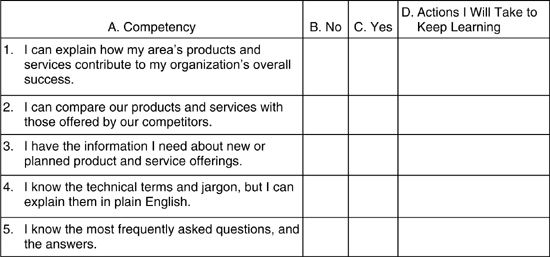
Section II. Customer Knowledge
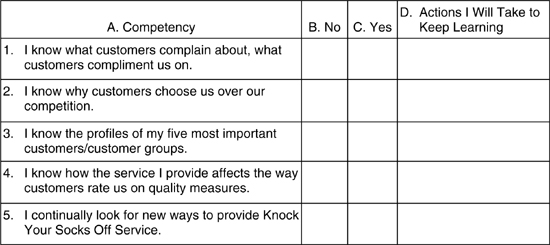
Section III. Technical/Systems Skills
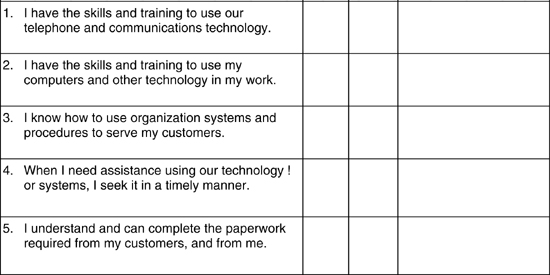
Section IV. Interpersonal Skills
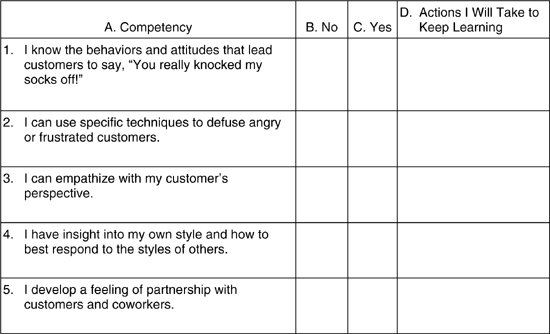
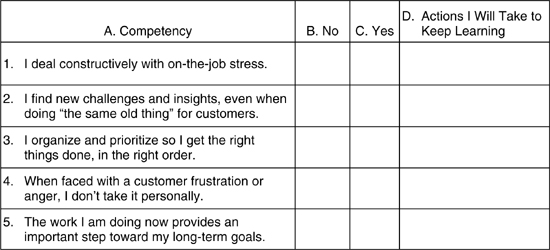
![]() Exercise 8-8. Worksheet: Building Your Talent Bank
Exercise 8-8. Worksheet: Building Your Talent Bank
Part I. Skills to Add
Instructions: In the space below list five knowledge or skill areas that you want to improve or add to your talent bank; for example, technical/systems skills, interpersonal skills, personal skills, product and service knowledge, and customer knowledge.
1. _______________________________________________________
2. _______________________________________________________
3. _______________________________________________________
4. _______________________________________________________
5. _______________________________________________________
Part II. Learning Plan
Instructions:
1. In Column A, identify two things you could do right now, without asking permission or investing a lot of money, to gain the desired knowledge or improve the skills you identified in Part I. For example, you may want to ask a coworker how she keeps her cool when customers burn red hot. Or you may ask to attend the next meeting of the local SOCAP (Society of Consumer Affairs Professionals, Alexandria, VA), ICSA (International Customer Service Association, Chicago), or Chamber of Commerce to hear a speaker on customer service skills.
2. In Column B, set a target date for completion of the step.
3. In Column C, describe the reward you will receive for completion; for example, sense of achievement, a new outfit, dinner out with friends, become eligible for promotion.
4. After you have completed your action step, use Column D to record your actual completion date.
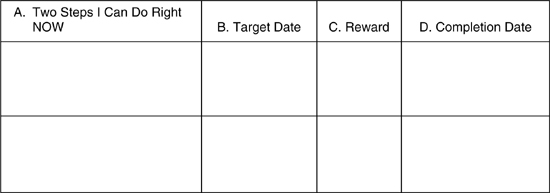
Part III. Long-Term Goals
Instructions:
1. In Column A, identify two long-term goals that would require greater effort from you and cooperation from others. For example, you may want to enroll in a local college to earn a degree. Or you may want to meet with your manager to find out how you can become an internal expert on your area’s computer systems.
2. In Column B, set a target date for completion of the goal.
3. In Column C, describe the reward you will receive for completion; for example, sense of achievement, a new outfit, dinner out with friends, become eligible for promotion.
4. After you have completed your action step, use Column D to record your actual completion date.

CELEBRATE SUCCESSES
You deserve a break today
—McDonald’s jingle
It’s true. You do deserve a break today—and every day! It’s important to take time out to celebrate your successes. Be good to yourself for doing a terrific job. No one else can celebrate as well as you can because no one else knows how well you’ve done.
If you’ve ever spent an hour or ten complaining about stupid customers or unsolvable problems—and who hasn’t?—remember the Federal Communications Commission (FCC) rule of equal time. Spend as much time, or better yet, more time, rehashing your successes. From time-to-time, go out with your colleagues and celebrate each other for surviving and thriving in the work you do. Is it bragging about yourself? Sure. But there’s no reason to downplay your skills and accomplishments. And recognizing your successes today will help motivate you to come back for more tomorrow.
Learning to Celebrate
Some people seem born knowing how to give themselves, and the people around them, needed pats on the back for work well done. But for most of us, celebrating ourselves doesn’t come easy. We get so embarrassed when others start to sing our praises that we wouldn’t even think of jumping in with a verse or two of our own. That’s an attitude Knock Your Socks Off Service professionals can—and should—learn to leave behind. Give yourself permission to be terrific. That’s right: You need to make a conscious decision to allow yourself to occasionally revel in doing well. Once you do, we guarantee you’ll learn to love the habit.
Still think it will be hard to get the hang of this positive feedback thing? Then start by practicing on someone else. Thank a colleague for helping you out. Make a point of letting your supervisor know something good about a coworker. Pass along a tip or trick you’ve learned from someone else—and make it clear who taught it to you.
Notice that the examples above have a common element: They focus attention first on an action or accomplishment, then on the individual or team of individuals involved. In other words, you’re not extolling someone just for being a wonderful person. Rather, you’re taking note of what they did and why it was so terrific. Now start doing the same thing for yourself.
Five Ways to Celebrate
There are countless ways to observe and have some fun with your service successes. But take a cue from what happened to the Doctor Seuss character Yertle the Turtle. He tried to celebrate his own worth by rising high on the backs of his fellow turtles. It worked for a while, but eventually Yertle met the fate shared by all who lift themselves up by putting others down: He ended up face-first in the mud. Standing tall on the merits of your own service successes means celebrating personal victories, but it means seeking out and celebrating the victories of your coworkers as well. Try the following five ways to celebrate.
1. Take Yourself Out to Lunch
Treat yourself to a special lunch or dinner or even breakfast. Invite a friend or coworker (or several) to go along and—this is the important part—make sure they know exactly what you are celebrating and why.
2. Take a Coworker Out to Lunch
This one works the same as the one above, only this time the reason for celebration is a good service performance by that person that has inspired you or given you added satisfaction or motivation in your job. Involving several others reinforces the teamwork and camaraderie that makes good service organizations something special to be a part of.
3. Buy Balloons or Flowers or Something Fun
A balloon or fresh-cut flower on your desk can symbolize a recent service achievement. It also brightens up your work space and lets other people know you’re feeling good about something. When they ask you, you’ll have a chance to explain, which will make you feel even better.
4. Make a “Brag Sheet”
When you spend a lot of time working on the skills you’d like to improve, it’s easy to forget to celebrate the strengths you already have. Start a list.
5. Tell Yourself “You Done Good!”
Think talking to yourself is a little strange? It isn’t. (Arguing with yourself, on the other hand, is a little suspect.) Good news gets better in the telling. If you’re not quite ready to shout it from the housetops, at least tell yourself—verbally, with force and feeling—that you’ve done a good job.
Exhibit 8–3, My Brag Sheet, is a sample “brag sheet” where you can list your strengths and your day-to-day victories. Or create your own brag sheet using colored pins and sketches that illustrate your strengths and achievements. Keep it in your daily organizer or at your desk in a special binder or file folder.
What gets rewarded gets repeated.
—Motivational principle
My Strengths
1. Example: Excellent product knowledge.
2. _______________________________________________________
3. _______________________________________________________
4. _______________________________________________________
5. _______________________________________________________
My Victories
1. Example: Calmed a very angry customer today. Did a good job at service recovery.
2. _______________________________________________________
3. _______________________________________________________
4. _______________________________________________________
5. _______________________________________________________
Providing Knock Your Socks Off Service shouldn’t be an impossible quest—or a personal ordeal. Like an athlete constantly in training, or a musician perfecting an instrument, you need to develop, evaluate, pace and manage yourself as well as your performance. That means work, but it also means celebrating a job well done.
In this chapter you learned:
• You’re not any good to anyone when you are stressed out. Stress reduction techniques include deep breathing, taking one-minute mental vacations, exercising, staying organized, and keeping a positive outlook. Find techniques that work best for you and practice them every day.
• On the job, your customers are customers first and foremost: You are the most helpful when you remain professional, but with a personal touch. The same principle applies to socializing with coworkers.
• Delivering Knock Your Socks Off Service means having a lifelong learning mentality and always looking for ways to improve your performance.
• Throughout your career, set improvement goals so you add to your talent bank.
• Take time out to celebrate your successes and those of your coworkers.
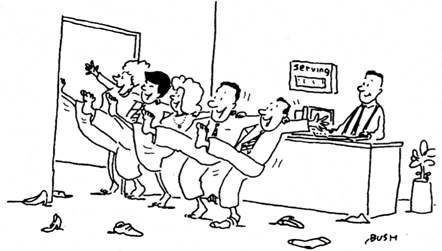
 Review Questions
Review Questions
1. When you practice deep breathing, hold your breath for no more than _______ seconds. |
1. (c) |
(a) 3 |
|
(b) 5 |
|
(c) 7 |
|
(d) 10 |
|
2. Knowing why customers choose your organization over the competition is an example of: |
2. (a) |
(a) customer knowledge. |
|
(b) personal skills. |
|
(c) technical/systems skills. |
|
(d) product and service knowledge. |
|
3. Organizing and prioritizing so you get the right things done in the right order is an example of: |
3. (a) |
(a) personal skills. |
|
(b) interpersonal skills. |
|
(c) product knowledge. |
|
(d) systems skills. |
|
4. When you celebrate successes, you are: |
4. (d) |
(a) wasting the organization’s time and money. |
|
(b) decreasing productivity. |
|
(c) being excessively self-promoting. |
|
(d) motivating yourself and others. |
|
5. Progressive muscle relaxation is a stress reduction technique where you: |
5. (a) |
(a) tense and relax specific muscles or specific muscle groups. |
|
(b) take one-minute vacations. |
|
(c) do desk aerobics. |
|
(d) let your anger and frustration out. |


